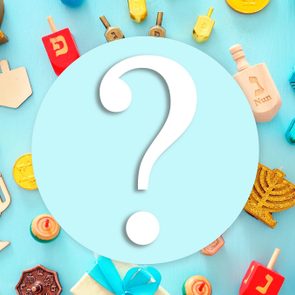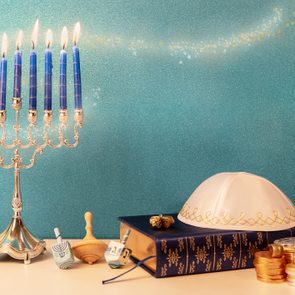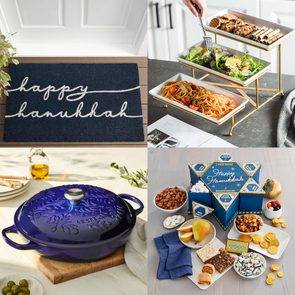8 Hanukkah Traditions That Make the 8-Night Holiday Special
Updated: Jan. 06, 2024

How is Hanukkah celebrated? Learn the history of the most common Hanukkah traditions that make up the Festival of Lights.
The holiday season heralds the arrival of Hanukkah, the eight-day Festival of Lights. Even in the most challenging times, Hanukkah is meant to be celebrated and cheered—in fact, it’s considered a mitzvah (a good deed, or commandment) for Jews to light candles to commemorate the historic victory. While many families have their own personal spins on the holiday (some observe a blended Chrismukkah), there are also classic Hanukkah traditions that always make the celebration special.
Get Reader’s Digest’s Read Up newsletter for more holiday tips, humor, cleaning, travel, tech and fun facts all week long.
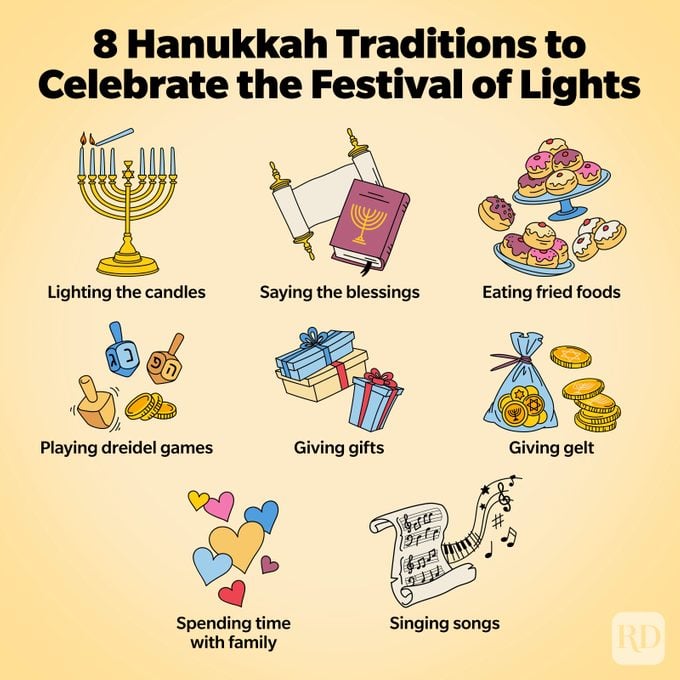
What is the story of Hanukkah?
Hanukkah is a joyous Jewish holiday that recalls an ancient miracle after a hard-fought victory over religious oppression. The historic event sparked Hanukkah traditions that last to this day.
In the first century B.C.E., Greek rulers banned Judaism. They tortured and persecuted those who dared practice and desecrated the holy Second Temple in Jerusalem, even sacrificing a pig and installing a statue of Zeus inside. A small band of Jewish warriors, led by Judah Maccabee, rebelled. When the battle was won, the Maccabees set out to rededicate the temple, which involved lighting candles on a menorah (a branched candelabra) that would burn continuously. Though they scoured the Second Temple, they found only enough oil to burn for one night. Miraculously, it burned for eight nights, which gave the Maccabees time to find more so they could keep the temple holy.
Today, Hanukkah celebrates that miracle and, by extension, the triumph of light over darkness. Those themes are evident in many of the most beloved Hanukkah traditions and in the giving of Hanukkah gifts.
What are Hanukkah traditions?
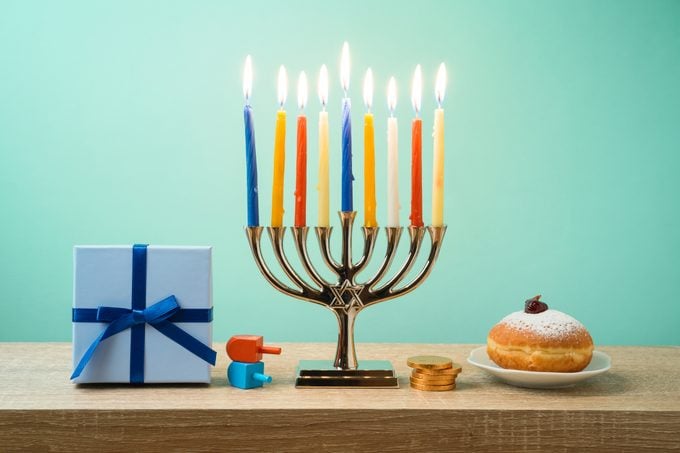
Lighting the Hanukkah candles
To commemorate the oil that miraculously lasted for eight days, modern-day Jewish families recite blessings and light candles on each of the eight nights of Hanukkah. Candles are placed in a menorah (sometimes a hanukkiah), with the number of lights increasing each night. This is the most important tradition of Hanukkah!
On the first night, one candle (plus a “helper” candle called the shammash) is lit. On the second night, two candles plus the shammash are lit. This continues until nine candles are blazing on the final night. This is why Hanukkah is often called the Festival of Lights. Families usually place lit menorahs in a window, following the guidance in the Talmud (one of the central texts in Judaism) to “publicize the miracle.”
Blessings
As the menorah candles are lit each night, there are three special blessings. Two are said for each of the eight nights, while one is said only for the first night. The blessings can be chanted or recited, and they are an important part of lighting the menorah. The first is a blessing of the candles. The second expresses thanksgiving for the miracle of deliverance that Hanukkah remembers. The third, said only on the first night of Hanukkah, is a prayer that marks beginnings and joyful occasions in Jewish life. These three blessings are an important and traditional part of Hanukkah celebrations!
Eating potato pancakes and jelly donuts
Walk into a Jewish kitchen during Hanukkah and you’re likely to inhale the delicious aroma of latkes, aka potato-and-onion pancakes fried in oil. If you’re especially lucky, sufganiyot, or jelly-filled doughnuts, will also be on offer. These decadent Jewish delicacies—along with other fried foods and Hanukkah desserts—symbolize the miracle of the oil. While latkes are more traditional, sufganiyot only became popular in the 20th century, when Israel promoted them as part of the country’s official Hanukkah celebration. Beginning in the 1970s, American Jews began adopting the delicious Hanukkah tradition.
Playing dreidel games
A dreidel is a four-sided spinning top used in games of chance during Hanukkah. Carved into or stamped onto every side is one of four Hebrew letters: nun, gimel, hey or shin. Each letter begins a word in the Hebrew phrase “nes gadol haya sham,” which means “a great miracle happened there.” Today, when players spin the dreidel, they win or lose gambling pieces—often small bits of candy—according to the letter they land on.
Kids (and even some adults) have been playing dreidel games at Hanukkah for centuries. No one is entirely sure how it all started. Theories range from the game being a way for young Jewish scholars to distract and trick Greek soldiers if they were caught illegally studying scripture, to the dreidel being based on a German game piece called trendel, which itself was based on an Irish spinning top known as teetotum.
Hanukkah gelt
At Hanukkah, Jewish children look forward to receiving small discs of chocolate, usually wrapped in gold- or silver-colored foil to resemble coins. Known as gelt, they’re sometimes used for betting during dreidel games but are often just enjoyed as a treat.
Historically, however, gelt was anything but kid stuff. In Eastern Europe, Jewish families would give a few extra coins to teachers, butchers and other independent workers as a sort of end-of-year tip. By the late 1800s, when survival was less fraught, families began giving small tokens to their children at Hanukkah.
However, some scholars say the Hanukkah tradition of giving gelt evolved earlier. The Talmud states that if a person cannot afford both Hanukkah lights and wine for the Sabbath, then the lights take precedence, according to Rabbi Norman Patz, rabbi emeritus of Temple Sholom of West Essex in Cedar Grove, New Jersey, and visiting rabbi of Temple Beth Shalom in San Juan, Puerto Rico. Giving gelt ensured that even the poorest people could light the Hanukkah menorah.
Gifts
Perhaps as an outgrowth of the gelt tradition, it’s customary during Hanukkah to make donations, or tzedakah, to nonprofits and other charitable organizations. In recent years, the sixth night of Hanukkah has become the designated time for families to give their gifts. Gifts may be monetary but can also include gifts of time as a volunteer. It’s also become popular for members of Jewish families to exchange gifts with one another, much like Christians do at Christmas. But that wasn’t always the case.
Despite being one of the Hanukkah traditions, gifts didn’t really take off until the 1950s. In the post-Holocaust era, promoting a positive Jewish identity to children became important. And as Christmas became increasingly commercialized, Jewish parents felt the need to offer something equivalent to their kids. While customs vary among families, many exchange one small gift for each of the first seven nights, with a bigger gift on the eighth night. Others buy something that can be used or experienced by the whole family, like a vacation.
Music
For many families, singing Hanukkah music together is one of the Hanukkah traditions. Songs range from serious to silly, including traditional songs like “Maoz Tzur,” composed in the 12th or 13th century, to modern children’s songs like “I Have a Little Dreidel.” Some families traditionally sing together after the lighting of the menorah, while others just enjoy Hanukkah music throughout the entire Festival of Lights.
Family time
Unlike many Jewish holidays, Hanukkah is celebrated primarily in the home, rather than in the synagogue. “It’s a home holiday. There’s no synagogue ritual for it,” Rabbi Patz says. In fact, the language in the Talmud mentions a “candle for each man and his household,” making the actual commandment one of celebrating at home with family. Families use this time together to celebrate all the Hanukkah traditions, from cooking fried foods and playing dreidel games to lighting candles and singing together. Even more so than the popular (and visible) gifts or gelt, Hanukkah at its heart is really about togetherness and celebration, which is why family time is one of the important Hanukkah traditions.
About the experts
- Rabbi Norman Patz is the rabbi emeritus of Temple Sholom of West Essex in Cedar Grove, New Jersey. He is also a visiting rabbi of Temple Beth Shalom in San Juan, Puerto Rico.
Sources:
- National Geographic: “How an ancient revolt sparked the Festival of Lights”
- History.com: “8 Hanukkah Traditions and Their Origins”
- Reform Judaism: “The History of Hanukkah Gifts: Is This Custom Really a Jewish One?”
- Library of Congress Blogs: “The Truth Behind the Hanukkah Dreidel: Metafolklore, Play, and Spin”



















